Market Overview
The Global Swarm Robotics Market size is projected to reach USD 1.9 billion in 2025 and grow at a compound annual growth rate of 25.6% from there until 2034 to reach a value of USD 14.7 billion.
Swarm robotics is a field of robotics that takes inspiration from nature, mainly from how insects like ants, bees, and birds work together in large groups. Instead of one powerful robot doing everything, swarm robotics focuses on using many simple robots that work together as a team to complete a task.
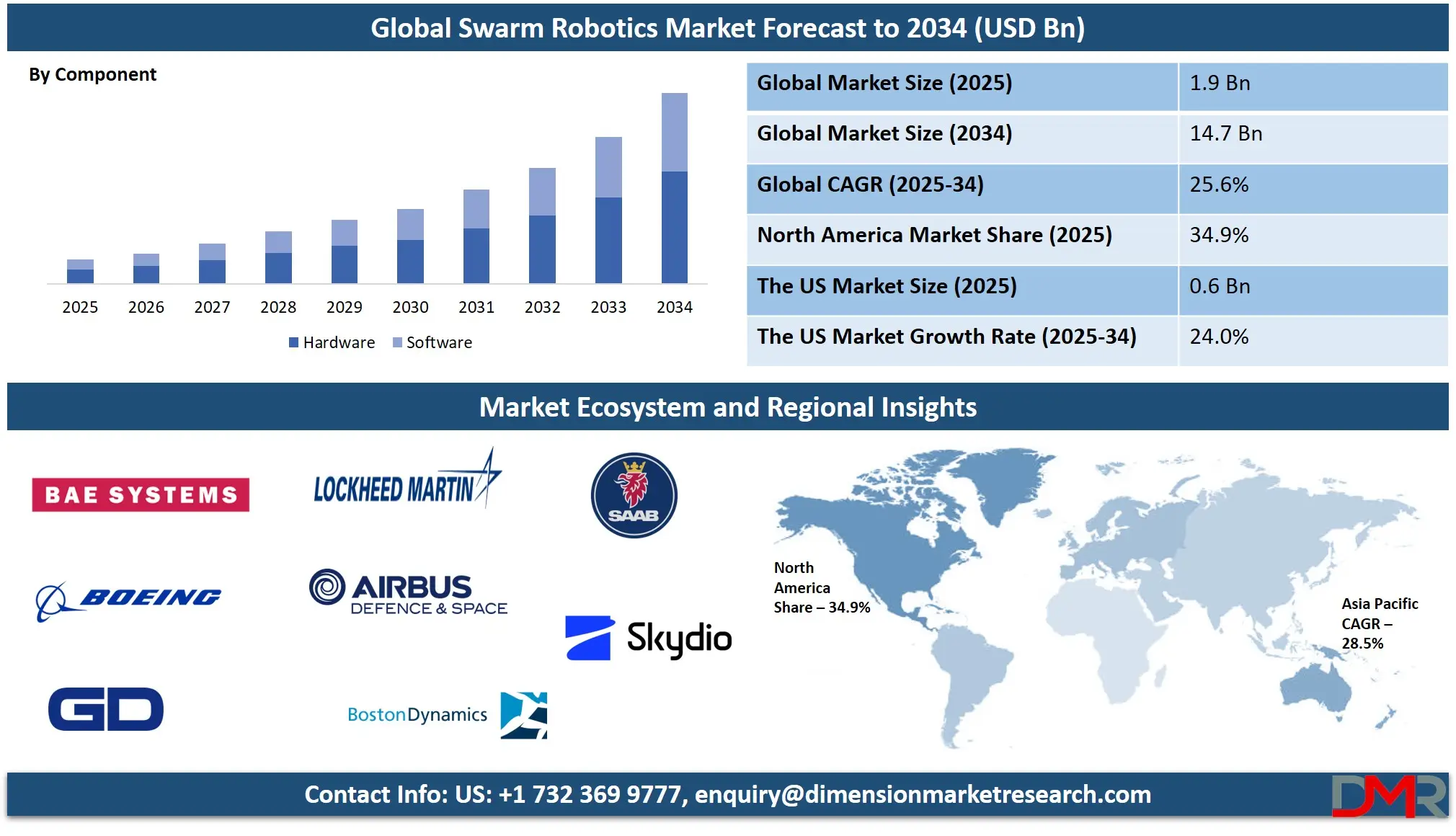
These robots are developed to follow simple rules, communicate with one another, and adjust their actions based on the group’s behavior. The idea is that by acting together, the swarm can do complex things that a single robot might struggle with, like exploring unknown places or cleaning large areas.
In recent years, there has been growing interest in swarm robotics due to its flexibility and usefulness in many industries. As technology improves and robots become smaller, smarter, and cheaper, more companies and researchers are finding ways to use swarm robotics in real-world applications, which includes agriculture, where small robots can work together to monitor crops in warehouses, where robots can sort and move packages and even in disaster zones, where swarms can search for survivors. This growth is driven by the need for automation in areas that are too dangerous or too large for humans or single machines to handle efficiently.
One of the most interesting trends is the move toward making these swarm robots more adaptive. Adaptive robots are those that can learn from their surroundings and change how they behave in real time. In swarm robotics, which helps the group responds better to changing environments or unexpected problems. For instance, if part of a swarm breaks down or gets lost, the others can adjust their actions to keep the task going. This makes the system more advanced and less likely to fail if something goes wrong.
Another related development is in autonomous service robots. These are robots that can perform tasks on their own without needing much human help. When these service robots are part of a swarm, they can do things like clean large buildings or deliver supplies across a hospital. Their independence & coordination as a team make them very efficient. When integrated with swarm intelligence, these robots can offer smarter, faster solutions to everyday problems.
In the past few years, several events have shown the progress and promise of swarm robotics. For instance, researchers have tested swarms of flying drones that can navigate tight spaces without crashing, which could be useful in search and rescue operations. Some companies have also demonstrated robot swarms in large-scale construction projects, where each robot has a small task, but together they build something big. Such examples show that swarm robotics is moving from labs into real-world settings with practical results.
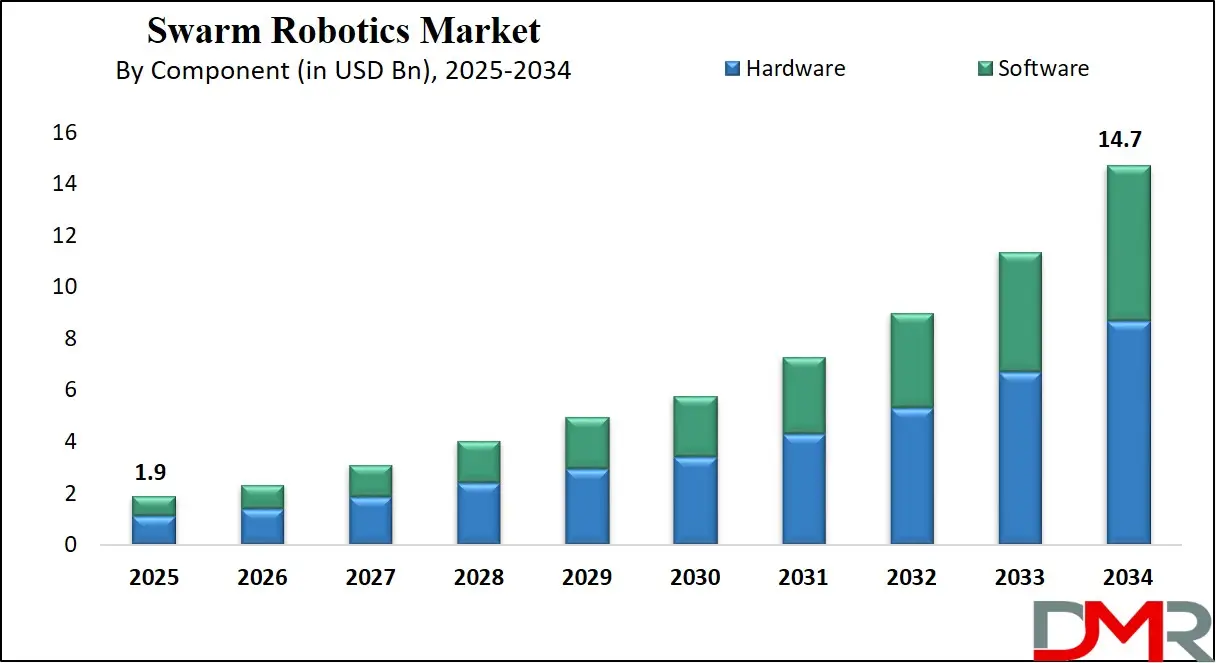
The US Swarm Robotics Market
The US Swarm Robotics Market size is projected to reach USD 0.6 billion in 2025 at a compound annual growth rate of 24.0% over its forecast period.
The US plays a leading role in the swarm robotics market due to its strong research capabilities and advanced technology ecosystem. Many universities and research institutions in the US focus on developing swarm robotics concepts, especially in AI, machine learning, and communication technologies that improve robot coordination. The US government and private sector invest heavily in robotics for defense, agriculture, and disaster response, driving innovation and real-world testing.
Startups and tech companies in the US are actively developing swarm robots for commercial and industrial use, helping to push the market forward. This combination of funding, talent, and industry demand positions the US as a key player shaping the future of swarm robotics globally.
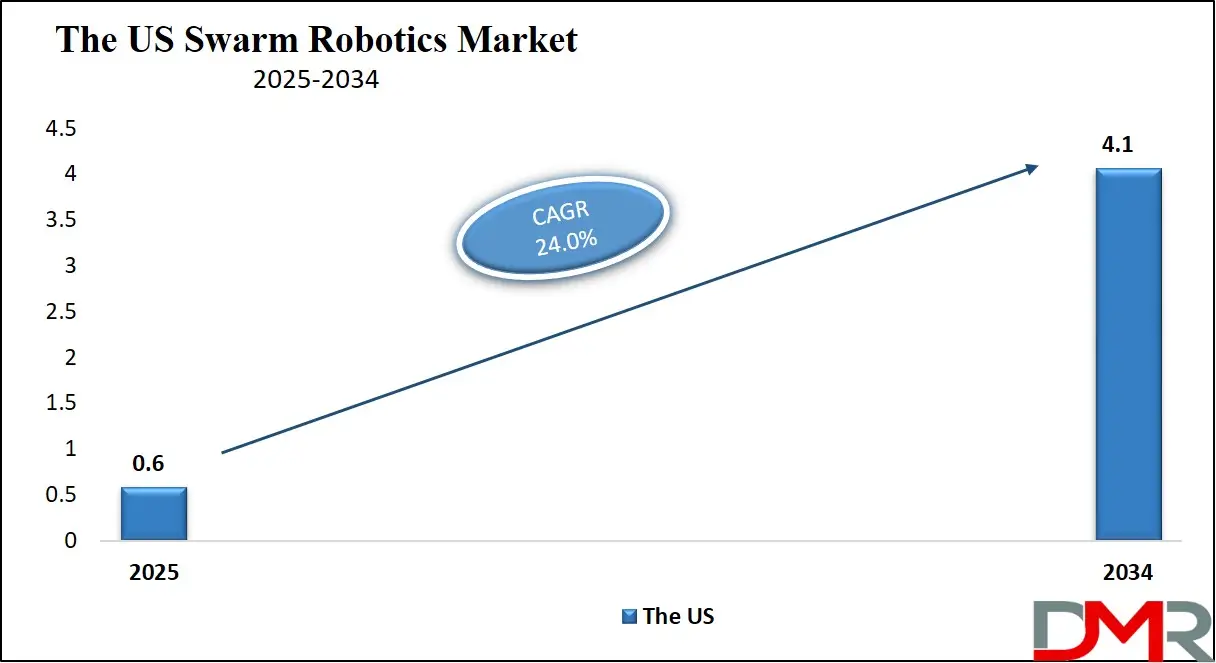
Europe Swarm Robotics Market
Europe Swarm Robotics Market size is projected to reach USD 0.5 billion in 2025 at a compound annual growth rate of 23.7% over its forecast period.
Europe plays a major role in the swarm robotics market through its strong focus on collaborative research and innovation. Many European countries support swarm robotics development via government-funded projects and partnerships between universities and industries. The region focuses on creating safe, reliable, and energy-efficient swarm systems, mainly for applications in agriculture, manufacturing, and environmental monitoring.
Europe’s strict regulations on technology and safety also push developers to create advanced, responsible solutions. In addition, European companies and research centers are working on integrating swarm robotics with other technologies like IoT and AI. This collaborative approach and focus on sustainable innovation make Europe an important contributor to the global growth and advancement of swarm robotics.
Japan Swarm Robotics Market
Japan Swarm Robotics Market size is projected to reach USD 0.1 billion in 2025 at a compound annual growth rate of 27.1% over its forecast period.
Japan plays a major role in the global swarm robotics market, using its advanced technological infrastructure and strong focus on R&D. The nation's commitment to innovation is evident through its active participation in international robotics conferences. Japanese institutions like Osaka University and Hiroshima University have pioneered research in biohybrid systems, notably developing cyborg insect swarms for applications in search-and-rescue operations and infrastructure inspection.
These innovations highlight Japan's leadership in integrating biological organisms with robotic systems to navigate complex terrains. Furthermore, Japan's industrial robotics sector, represented by organizations such as the Japan Robot Association (JARA), continues to drive advancements in swarm robotics. JARA's initiatives, including the International Robot Exhibition (IREX), showcase Japan's dedication to promoting robotics technology and fostering collaboration between industry and academia. Collectively, Japan's robust research ecosystem, industrial capabilities, and commitment to innovation position it as a key contributor to the evolution and application of swarm robotics worldwide.
Swarm Robotics Market: Key Takeaways
- Market Growth: The Swarm Robotics Market size is expected to grow by USD 12.4 billion, at a CAGR of 25.6%, during the forecasted period of 2026 to 2034.
- By Component: The hardware segment is anticipated to get the majority share of the Swarm Robotics Market in 2025.
- By End User: The government & defense segment is expected to get the largest revenue share in 2025 in the Swarm Robotics Market.
- Regional Insight: North America is expected to hold a 34.9% share of revenue in the Global Swarm Robotics Market in 2025.
- Use Cases: Some of the use cases of Swarm Robotics include warehouse automation & logistics, agricultural monitoring & farming, and more.
Swarm Robotics Market: Use Cases
- Disaster Response and Search Operations: Swarm robots can be easily deployed in disaster-hit areas like collapsed buildings or forests during fires. They spread out to cover large spaces, search for survivors, and map dangerous zones. Their ability to work without central control makes them reliable even when communication lines are down.
- Agricultural Monitoring and Farming: In farming, swarms of small robots can monitor soil health, check plant growth, and even perform planting or spraying tasks. They can cover wide areas at once, work around the clock, and adjust based on real-time data, which helps farmers manage crops more efficiently and reduce labor costs.
- Warehouse Automation and Logistics: Swarm robotics is transforming how warehouses operate by allowing small robots to work together to move goods, sort packages, and restock shelves. These robots coordinate in real time, avoid collisions, and improve speed. This boosts productivity and reduces errors in busy storage environments.
- Environmental Monitoring and Exploration: Swarm robots can explore hard-to-reach environments like oceans, volcanoes, or polluted sites. They collect data on temperature, air quality, or water levels without risking human lives. Because they share information and adjust movements, they can gather more detailed and accurate environmental data.
Market Dynamic
Driving Factors in the Swarm Robotics Market
Advancement in Artificial Intelligence and Miniaturization of Technology
One of the main drivers behind the growth of the swarm robotics market is the rapid improvement in artificial intelligence and the miniaturization of hardware components. AI allows individual robots to make smarter decisions and adapt their behavior based on their environment and the actions of other robots, which is essential for swarm coordination, mainly in unpredictable or complex settings.
At the same time, smaller and more affordable sensors, processors, and batteries have made it possible to build compact robots with powerful capabilities. As these components become cheaper and more efficient, it becomes easier to deploy large numbers of robots in a swarm, which allows new utilization in fields such as agriculture, defense, and environmental monitoring, where size, cost, and adaptability matter most.
Growing Demand for Automation in Large-Scale and High-Risk Tasks
Another strong growth driver is the growing need for automation in tasks that are either too dangerous, too large, or too repetitive for humans to perform efficiently. Swarm robotics offers a flexible and scalable solution, where multiple robots can share the workload, adjust in real time, and continue operating even if some units fail. Industries like disaster management, logistics, and military operations benefit from this approach, as it minimizes human risk and improves operational speed.
In warehouses, for instance, swarm robots can move and sort packages quickly without needing direct supervision. In search and rescue missions, they can explore unsafe areas while keeping rescuers out of harm’s way. As more industries face labor shortages or need more precise, round-the-clock operations, the demand for swarm-based automation continues to rise.
Restraints in the Swarm Robotics Market
Complexity in Coordination and Communication
One major restraint in the swarm robotics market is the challenge of ensuring smooth coordination and reliable communication among a large number of robots. Since swarm robots depend heavily on sharing information and working together, any communication breakdown can cause the whole system to fail or perform poorly.
Managing hundreds or even thousands of robots to act as one unit demands advanced algorithms and stable wireless connections, which are still difficult to perfect. Environmental factors like interference or obstacles can disrupt signals, making real-world deployment tricky, which enhances the development costs and slows down the adoption of swarm robotics in many industries.
High Initial Investment and Technical Barriers
Another major restraint is the high upfront cost and technical expertise needed to develop and implement swarm robotics systems. Designing and programming multiple robots that can operate autonomously and adaptively involves advanced research and engineering, which can be costly and time-consuming.
Small and medium-sized businesses may find it hard to invest in such technology without clear short-term returns. In addition, integrating swarm robots into existing workflows or infrastructure needs specialized knowledge and training for staff. These factors limit the market’s growth, mainly in regions or sectors where technology budgets and skills are limited.
Opportunities in the Swarm Robotics Market
Expansion into Healthcare and Medical Applications
The healthcare sector offers a promising opportunity for the swarm robotics market as the need for efficient, precise, and scalable solutions grows. Swarm robots can help in tasks like disinfecting hospitals, delivering medicines, or even performing coordinated micro-surgeries in the future.
Their ability to work together in tight spaces and adapt to dynamic environments makes them ideal for crowded medical settings. With the expansion of telemedicine and remote healthcare, swarm robotics could provide automated support that minimizes the workload on medical staff. As healthcare providers look for safer and faster ways to deliver services, integrating swarm robotics provides a chance for significant growth and innovation.
Integration with Internet of Things (IoT) and Smart Cities
Swarm robotics holds great potential in the development of smart cities, where robots can work together to manage urban infrastructure more efficiently. Connected through Internet of Things (IoT) networks, swarm robots can monitor traffic, maintain public spaces, and assist in waste management with minimal human supervision.
This integration allows for real-time data sharing and quicker responses to city needs like road repairs or emergencies. As urban populations grow, the demand for automated, scalable solutions to maintain city services will increase. Swarm robotics, combined with IoT, offers a valuable opportunity to create safer, cleaner, and more responsive urban environments.
Trends in the Swarm Robotics Market
Integration of Artificial Intelligence and Edge Computing
A major trend in the swarm robotics market is the integration of artificial intelligence (AI) and edge computing technologies. AI enables robots to make real-time decisions, adapt to dynamic environments, and perform complex tasks autonomously.
Edge computing allows data processing closer to the source, reducing latency and bandwidth usage. This combination enhances the responsiveness and efficiency of robot swarms, making them suitable for applications like search and rescue missions, environmental monitoring, and industrial automation. The adoption of these technologies is expected to drive market growth by improving the performance and scalability of swarm robotic systems.
Adoption in Smart Manufacturing and Logistics
Swarm robotics is mainly being adopted in the smart manufacturing and logistics sectors. These industries require flexible, scalable, and efficient solutions to meet the demands of modern production and supply chain management. Robot swarms can collaborate to perform tasks such as material handling, assembly, and inventory management, improving operational efficiency and reducing human labor costs. The growing trend towards automation and the need for agile manufacturing processes are driving the adoption of swarm robotics in these sectors.
Research Scope and Analysis
By Component Analysis
Hardware as a component in the swarm robotics market is expected to lead in 2025 with a share of around 58.9%, which is driven by the need for reliable sensors, processors, communication devices, and power sources that allow swarm robots to operate efficiently and coordinate well. Advances in miniaturization and energy-efficient hardware have made it possible to build smaller, faster, and more durable robots.
These improvements help swarms perform tasks in challenging environments such as agricultural fields, warehouses, and disaster zones. The increasing demand for better hardware also supports the development of more complex and adaptable robotic systems. As a result, investment in hardware technology plays a crucial role in expanding the swarm robotics market and enabling new applications worldwide.
Further, software as a component is expected to see significant growth over the forecast period in the swarm robotics market. Software controls how swarm robots communicate, make decisions, and work together to complete tasks without direct human control. It enables autonomous service robots to operate independently in areas like cleaning, delivery, and maintenance, improving efficiency and reducing the need for manual supervision.
The rise of artificial intelligence and machine learning helps software make swarm robots more adaptive and capable of handling unexpected situations. With growing demand for smarter robotic systems, software development is becoming a key factor in driving innovation and expanding the use of swarm robotics across various industries.
By Platform Analysis
Ground-based platforms in the swarm robotics market are expected to lead in 2025 with a share of about 45.8%, which comes from their wide use in industries like agriculture, logistics, and manufacturing, where robots move on land to perform tasks like material handling, inspection, and monitoring.
Ground-based robots are often easier to deploy in complex environments like warehouses or farms, where they can work together efficiently to cover large areas. Development in durable hardware, sensors, and navigation systems helps these robots operate safely and adapt to different terrains. Their ability to work as a coordinated swarm improves productivity and reduces labor costs. Because of these benefits, ground-based platforms will continue to play a major role in expanding the swarm robotics market.
Aerial (UAVs) platforms in the swarm robotics market are set to see significant growth over the forecast period. These flying robots are used for tasks such as surveillance, crop monitoring, and delivery, where their ability to access hard-to-reach areas is a big advantage. Autonomous service robots within this segment can operate without constant human control, making them valuable for real-time data collection and emergency response.
Improvements in AI and communication systems help these UAVs coordinate as swarms, allowing faster and more accurate task completion. As industries look for flexible and scalable automation solutions, aerial swarm robots will increasingly become essential in agriculture, security, and logistics.
By Technology Analysis
Based on technology, bio-inspired algorithms in the swarm robotics market are expected to lead in 2025 with a share of 29.6%. These algorithms are designed by observing how nature works, like how ants find food or birds fly in flocks, and applying those patterns to how robots behave. In a swarm, robots using bio-inspired algorithms can work together without a central controller, making decisions based on simple rules and local information, which allows them to adapt to changing environments, solve problems as a group, and remain functional even if some units fail.
These features are ideal for real-world use in areas like search and rescue, environmental monitoring, and agriculture. As industries look for smarter, self-organizing robotic systems, the demand for bio-inspired technology in swarm robotics will continue to grow and support market expansion.
Further, reinforcement learning as a technology is expected to see significant growth over the forecast period in the swarm robotics market. This method allows robots to learn from experience by trying different actions and learning from the results, much like how humans learn through trial and error.
In the context of autonomous service robots, reinforcement learning helps them become more efficient over time, improving how they perform tasks such as delivery, cleaning, and surveillance without human help. When applied to swarms, it lets robots adjust their actions based on real-time feedback, which helps the entire group operate more effectively. As industries push for intelligent and self-improving systems, reinforcement learning will play an important role in boosting the capabilities and adoption of swarm robotics.
By Application Analysis
Military & defense as an application in the swarm robotics market is set to lead in 2025 with a share of 29.6%. This growth comes from the increasing demand for smart, fast, and coordinated robotic systems that can support missions without risking human lives. Swarm robots can be used for tasks like surveillance, reconnaissance, explosive detection, and battlefield support. Their ability to operate as a group, communicate in real-time, and adapt to changing environments makes them valuable in modern military strategies.
These robots are also harder to detect and disable compared to a single large machine, offering a tactical advantage. Governments are investing heavily in swarm robotics technology to strengthen defense systems, which continues to drive market growth in this segment. The focus on safety, efficiency, and automation is pushing military and defense forward as key users of swarm robotics worldwide.
Disaster management and search & rescue are set to experience significant growth as applications in the swarm robotics market over the forecast period. These situations often involve unpredictable environments, where human access is limited or dangerous. Autonomous service robots operating in swarms can spread out, search wide areas quickly, and work together to find survivors or assess damage.
Their ability to move through rubble, navigate challenging terrain, and communicate with each other in real time makes them ideal for emergency response. These robots can also deliver supplies or relay information to rescue teams. As the need for faster and safer disaster response continues to grow, swarm robotics offers a promising solution. With ongoing advancements in robotics and AI, this application area will see strong adoption across many countries and organizations.
By End User Analysis
Government & defense as an end user in the swarm robotics market is expected to lead in 2025 with a share of 35.1%. This growth is fueled by the rising need for secure, efficient, and intelligent robotic systems to support national security, border patrol, and tactical missions. Swarm robotics allows defense forces to deploy multiple robots that can communicate, coordinate, and adapt in real time, improving surveillance, search missions, and threat detection. Governments are also funding large-scale research programs and pilot projects to develop these technologies further.
The ability of swarm robots to operate in harsh or risky conditions without human presence adds to their appeal. As defense and public security needs grow more complex, swarm robotics is becoming a crucial tool for governments to maintain safety and readiness across various scenarios.
The industrial sector is expected to witness significant growth in the swarm robotics market over the forecast period. With the push toward smart manufacturing and automation, industries are using autonomous service robots in swarms to handle repetitive tasks like sorting, assembly, and material transport. These robots can work together efficiently, adapt to workflow changes, and reduce downtime, improving overall productivity.
In warehouses, swarm robots help manage inventory, reduce labor costs, and speed up order fulfillment. As demand rises for faster and more flexible production processes, especially in sectors like automotive, electronics, and logistics, swarm robotics offers practical and scalable solutions. With advancements in AI and machine communication, the industrial sector is likely to increase adoption and drive steady market expansion.
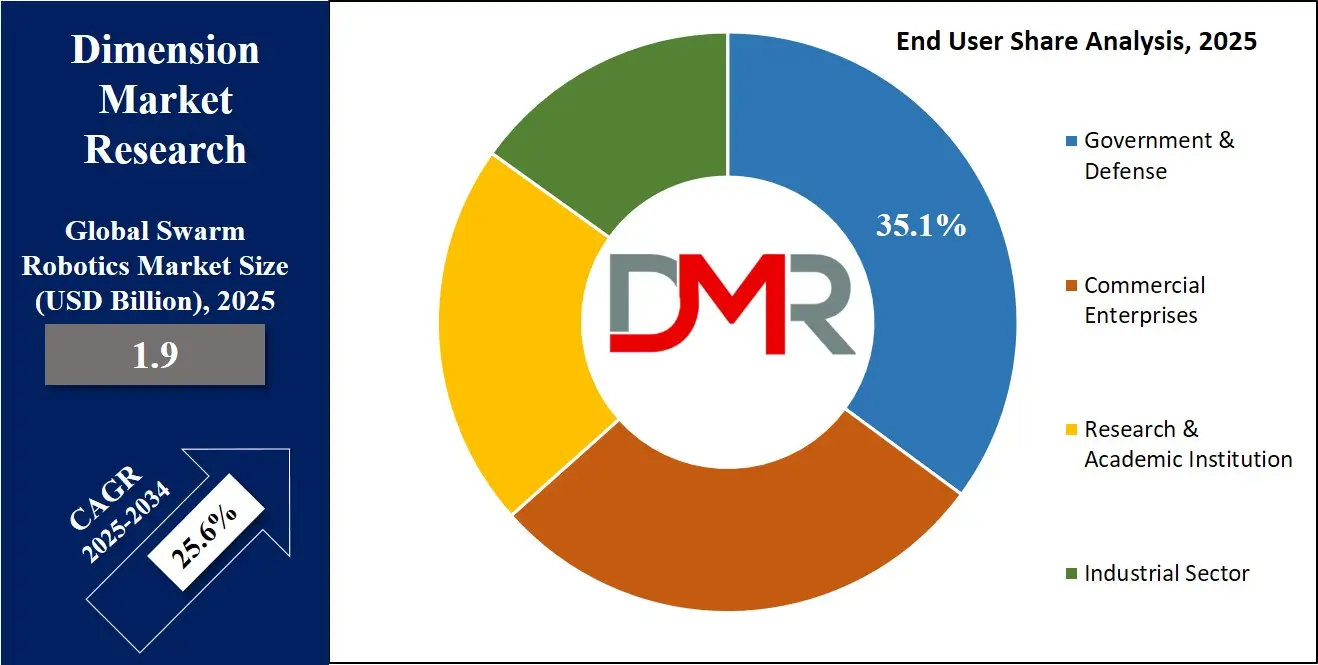
The Swarm Robotics Market Report is segmented on the basis of the following:
By Component
- Hardware
- Sensors
- Actuators
- Controllers
- Communication Systems
- Software
- Simulation Software
- Swarm Intelligence Algorithms
- Control Interfaces
By Platform
- Ground-based Robots
- Aerial Robots (UAVs)
- Underwater Robots
- Hybrid Robots
By Technology
- Bio-inspired Algorithms
- Optimization Algorithms
- Reinforcement Learning
- Particle Swarm Optimization (PSO)
- Ant Colony Optimization (ACO)
- Others
By Application
- Military & Defense
- Agriculture
- Industrial Automation
- Warehouse & Logistics
- Mining
- Environmental Monitoring
- Disaster Management & Search and Rescue
- Surveillance & Inspection
- Healthcare
- Others
By End User
- Government & Defense
- Commercial Enterprises
- Research & Academic Institutions
- Industrial Sector
Regional Analysis
Leading Region in the Swarm Robotics Market
North America is estimated to lead the swarm robotics market in 2025, holding a significant share of around 34.9%. The region's strong position is driven by advanced technology development, well-established research institutions, and significant investments from both the government and private sectors. North America has a large number of companies focused on creating innovative swarm robotics solutions for industries like defense, agriculture, logistics, and healthcare.
The growing demand for automation and smart systems to improve efficiency and safety in these industries further supports market growth. Additionally, advancements in artificial intelligence, communication technologies, and robotics hardware make North America a key hub for swarm robotics innovation. The collaboration between academic research and industry players also helps accelerate the development and adoption of swarm robots in practical applications. These factors combined make North America a dominant and growing force in the global swarm robotics market.
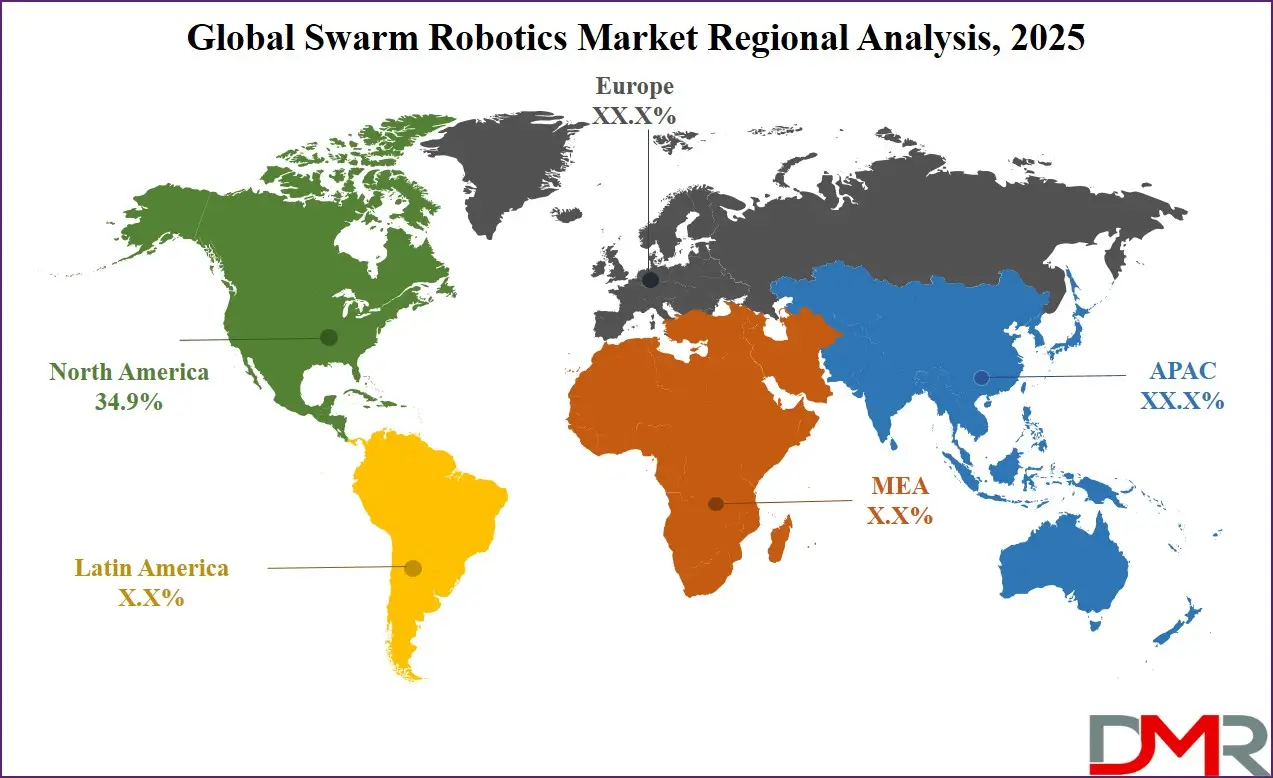
Fastest Growing Region in the Swarm Robotics Market
Asia Pacific is showing significant growth in the swarm robotics market over the forecast period, driven by rapid industrialization and increasing adoption of automation technologies. Countries in this region are investing heavily in research and development, focusing on smart manufacturing, agriculture, and logistics applications. The rising need for efficient, cost-effective robotic solutions to handle large-scale tasks supports the market expansion.
Additionally, improvements in artificial intelligence, communication networks, and sensor technologies are enabling more advanced and reliable swarm robotics systems. Growing government support and rising awareness about robotics benefits further boost the region’s market. As a result, Asia Pacific is becoming an important player in the global swarm robotics industry..
By Region
North America
Europe
- Germany
- The U.K.
- France
- Italy
- Russia
- Spain
- Benelux
- Nordic
- Rest of Europe
Asia-Pacific
- China
- Japan
- South Korea
- India
- ANZ
- ASEAN
- Rest of Asia-Pacific
Latin America
- Brazil
- Mexico
- Argentina
- Colombia
- Rest of Latin America
Middle East & Africa
- Saudi Arabia
- UAE
- South Africa
- Israel
- Egypt
- Rest of MEA
Competitive Landscape
The swarm robotics market is becoming more competitive as interest grows across different industries like agriculture, logistics, defense, and healthcare. Many companies and research groups are working to create smarter, more flexible, and affordable robots that can work in groups. As technology gets better, especially in areas like sensors, artificial intelligence, and wireless communication, more players are entering the market with new ideas and solutions.
The competition is also fueled by the need for robots that can handle complex tasks with little human help. Startups and established tech developers are focusing on improving how swarm robots cooperate, adapt to their surroundings, and complete tasks more efficiently. This rising competition is pushing innovation and speeding up the growth of real-world swarm robot applications.
Some of the prominent players in the global Swarm Robotics are:
- BAE Systems
- Lockheed Martin
- Airbus Defense & Space
- SAAB AB
- Boeing
- General Dynamics
- Boston Dynamics
- SwarmFarm Robotics
- Skydio
- Textron Systems
- Raytheon Technologies
- Northrop Grumman
- RRAI
- Dedrone
- Voliro
- Flock
- Flytrex
- Pensa Systems
- Roboswarm Inc
- Other Key Players
Recent Developments
- In March 2025, UBTECH Robotics completed the world’s first multi-humanoid robot collaborative training program at Zeekr’s 5G Intelligent Factory, which is a breakthrough in industrial automation, showcasing the effective use of swarm intelligence with humanoid robots. The program demonstrated how multiple robots can work together across various tasks and scenarios, signaling a new era of intelligent, flexible automation in manufacturing environments and setting the stage for broader applications of collaborative robotics in industry.
- In August 2024, Swarmbotics AI announced that the company raised USD 4 million in its latest funding round, marking a major step toward transforming swarm robotics for industry and defense. As a low-cost robotics pioneer, the company focuses on using off-the-shelf components and advanced autonomous systems to enable efficient, collaborative robot swarms. This funding will boost R&D, enhance its global planner technology, and support scalable, affordable solutions.
Report Details
| Report Characteristics |
| Market Size (2025) |
USD 1.9 Bn |
| Forecast Value (2034) |
USD 14.7 |
| CAGR (2025–2034) |
25.6% |
| Historical Data |
2019 – 2024 |
| The US Market Size (2025) |
USD 0.6 Bn |
| Forecast Data |
2025 – 2033 |
| Base Year |
2024 |
| Estimate Year |
2025 |
| Report Coverage |
Market Revenue Estimation, Market Dynamics, Competitive Landscape, Growth Factors, etc. |
| Segments Covered |
By Component (Hardware and Software), By Platform (Ground-based Robot, Aerial Robots (UAVs), Underwater Robots, and Hybrid Robots), By Technology (Bio-inspired Algorithms, Optimization Algorithms, Reinforcement Learning, Particle Swarm Optimization (PSO), Ant Colony Optimization (ACO), Others), By Application (Military & Defense, Agriculture, Industrial Automation, Warehouse & Logistics, Mining, Environmental Monitoring, Disaster Management & Search and Rescue, Surveillance & Inspection, Healthcare, and Others), By End User (Government & Defense, Commercial Enterprises, Research & Academic Institutions, and Industrial Sector) |
| Regional Coverage |
North America – US, Canada; Europe – Germany, UK, France, Russia, Spain, Italy, Benelux, Nordic, Rest of Europe; Asia-Pacific – China, Japan, South Korea, India, ANZ, ASEAN, Rest of APAC; Latin America – Brazil, Mexico, Argentina, Colombia, Rest of Latin America; Middle East & Africa – Saudi Arabia, UAE, South Africa, Turkey, Egypt, Israel, Rest of MEA |
| Prominent Players |
BAE Systems, Lockheed Martin, Airbus Defense & Space, SAAB AB, Boeing, General Dynamics, Boston Dynamics, SwarmFarm Robotics, Skydio, Textron Systems, Raytheon Technologies, Northrop Grumman, RRAI, Dedrone, Voliro, Flock, Flytrex, Pensa Systems, and Roboswarm Inc, and Other Key Players |
| Purchase Options |
We have three licenses to opt for: Single User License (Limited to 1 user), Multi-User License (Up to 5 Users), and Corporate Use License (Unlimited User) along with free report customization equivalent to 0 analyst working days, 3 analysts working days, and 5 analysts working days respectively. |
Frequently Asked Questions
The Global Swarm Robotics Market size is expected to reach a value of USD 1.9 billion in 2025 and is expected to reach USD 14.7 billion by the end of 2034.
North America is expected to have the largest market share in the Global Swarm Robotics Market, with a share of about 34.9% in 2025.
The Swarm Robotics Market in the US is expected to reach USD 0.6 billion in 2025.
Some of the major key players in the Global Swarm Robotics Market are SAAB, BAE System, Boeing, and others
The market is growing at a CAGR of 25.6 percent over the forecasted period.